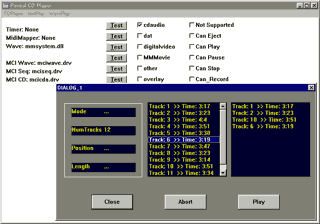Advanced Windows Capabilities with Multimedia
Author: Charles Calvert
Language: Borland Pascal for Windows
Location: 1993 Borland International Conference
 This paper focuses on the world of multimedia sound as
represented by wave files, midi files, and CD players.
The Tools and Definitions
Papers of this type usually dive right into the code itself,
with little delay. But multimedia tools are so new, and the
technology involved so daunting, that it would perhaps be
helpful to spend a few moments clarifying certain issues.
The first to come to grips with is MPC, or Multimedia PC. This
is a hardware standard meant to define the minimum
configuration of any personal computer that can play multimedia
programs. The key elements in the MPC standard are a 386 or
better computer with a VGA video system, a mouse, a sound
board, and a CD-ROM.
The programs in this paper were tested on two 486s, one
equipped with Creative Labs' Sound Blaster Pro card and the
other with a NEC CD-ROM drive. The first is a requirement for
playing MIDI files, and the second for playing CDs.
If you don't have either of these tools then you will not be
able to run any of the code accompanying this paper. It is
important to understand that the widely distributed Speaker.drv
file will not be enough to allow you to run the included code.
The reason for this is that the calls used in this paper are
too low level for the
This paper focuses on the world of multimedia sound as
represented by wave files, midi files, and CD players.
The Tools and Definitions
Papers of this type usually dive right into the code itself,
with little delay. But multimedia tools are so new, and the
technology involved so daunting, that it would perhaps be
helpful to spend a few moments clarifying certain issues.
The first to come to grips with is MPC, or Multimedia PC. This
is a hardware standard meant to define the minimum
configuration of any personal computer that can play multimedia
programs. The key elements in the MPC standard are a 386 or
better computer with a VGA video system, a mouse, a sound
board, and a CD-ROM.
The programs in this paper were tested on two 486s, one
equipped with Creative Labs' Sound Blaster Pro card and the
other with a NEC CD-ROM drive. The first is a requirement for
playing MIDI files, and the second for playing CDs.
If you don't have either of these tools then you will not be
able to run any of the code accompanying this paper. It is
important to understand that the widely distributed Speaker.drv
file will not be enough to allow you to run the included code.
The reason for this is that the calls used in this paper are
too low level for the
|